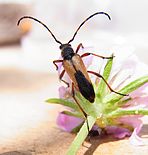Paracorymbia stragulata
| Paracorymbia stragulata | ||||||||||||
|---|---|---|---|---|---|---|---|---|---|---|---|---|

Paracorymbia stragulata on yarrow |
||||||||||||
| Systematics | ||||||||||||
|
||||||||||||
| Scientific name | ||||||||||||
| Paracorymbia stragulata | ||||||||||||
| ( Germar , 1824) |
Paracorymbia stragulata is a beetle from the family of the longhorn beetle and the subfamily of the narrow blocks . The genus Paracorymbia comprises 16 species worldwide , nine of which can be found in Europe. Paracorymbia stragulata is found on flowers in southwestern Europe.
Notes on the name
The species was first described by Germar in 1824 under the name Leptura stragulata as the 701st species of new or little-known beetle . The name is Germar by Illigeri ( lat. Of Illiger or by Illiger ) added. The description contains no clear indication of why Germar gave the name stragulāta (Latin with a blanket, strāgula, provided).
The genus Paracorymbia was introduced by Miroshnikov in 1998. The name is from old Gr. παρά pará, “next to” and derived from the generic name Corymbia , which was introduced in 1886 by Des Gozis. The name says that the two genera Corymbia and Paracorymbia are similar.
Physique of the beetle
The beetle is similar in shape to the red-necked buck, which is common in Central Europe . Body color and pattern of the wing covers vary.
The black head is slanted downwards in relation to the body axis. It is hairy yellow and densely dotted . The antennae are eleven-segmented and either black or ringed, but the color is not gender specific. You can distinguish the sexes by the structure of the antennae. In the male they are flattened from the fifth to the ninth member and clearly serrated on the outside (Fig. 1 and 3 above). In the female, on the other hand, the antennae are rounder and the teeth are at most weakly developed (Fig. 2, 3 and 4 below).
The pronotum is longer than it is wide and narrows towards the head in a bell shape. It is constricted at the base and at the front end. The back corners are blunt and slightly bulged to the side. The pronotum is completely black, dotted, and hairy yellowish. The label is black.
The wing covers become narrower towards the rear, their rear end is sloping and slightly concave, the acute angle is on the outside (Fig. 5). They are hairy yellowish and have deep and dense puncturing, which becomes weaker towards the back. In the original description, the color is specified as black except for a light brown triangular spot on the label and a short light brown stripe on the side . Mulsant, on the other hand, mentions yellow-brown wings as the normal case with a black stripe on the shoulder and another black stripe on the wing cover seam, which is particularly wide at the back. Then he names five variants that result from reducing or expanding the black areas (Fig. 1 to 3).
The underside is black or yellow-red and sparsely hairy.
biology
The beetles appear in late spring, the reports of findings at an insect forum in France are between May and August with the maximum in July.
distribution
The species is only known from southwest France, Spain and Portugal.
literature
- Étienne Mulsant: Histoire naturelle des coléoptères de France, Longicornes. Paris 1862/63, pp. 547ff., At BHL .
Individual evidence
- ↑ a b Paracorymbia stragulata in Fauna Europaea. Retrieved December 8, 2013
- ↑ Taxon profile Paracorymbia Miroshnikov, 1998 BioLib, accessed December 8, 2013
- ↑ a b Paracorymbia at Fauna Europaea. Retrieved December 8, 2013
- ^ Ernst Friedrich Germar : Coleopterorum species novae aut minus cognitae, descriptionibus illustratae. Halle 1824, p. 523, preview in the Google book search.
- ↑ Sigmund Schenkling: Explanation of the scientific beetle names (species)
- ↑ M. Des Gozis: Recherche de l'espèce typique de quelques anciens genres, rectifications synonymiques et notes diverses. Montluçon 1886, p. 33, at BHL p. 33
- ↑ bottom Répartition sur l'année from Monde des Insectes




